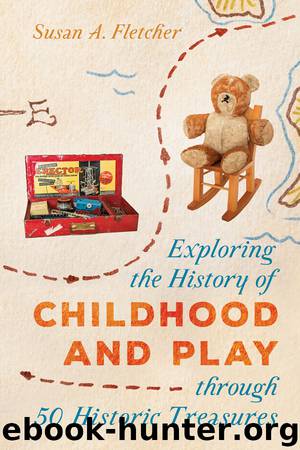Exploring the History of Childhood and Play through 50 Historic Treasures by Susan A. Fletcher

Author:Susan A. Fletcher
Language: eng
Format: epub
Publisher: Rowman & Littlefield Publishers
Published: 2020-02-18T00:00:00+00:00
Part VII
ACTION FIGURES
On Christmas Day 1987, a boy named Dan ran downstairs at his grandmother’s house to the awaiting Christmas tree and presents. To his sheer delight, “Standing on top of the boxes were Kenner’s Real Ghostbuster’s Action Figures, the four main Ghostbusters.… They all had their proton packs strapped to their backs, and all of them were busting their little companion ghosts that came packaged with them.”1 Action figures were much-anticipated gifts under many Christmas trees in the 1980s. Kids across the country tore open packages of G.I. Joes, He-Man, Ghostbusters, and other action heroes. In this part, we’ll look at the development of action figures from the metal toy soldiers of the nineteenth century to the colorful Teenage Mutant Ninja Turtles of the 1980s. Along the way, we’ll explore these toys’ relationships to war and violence, and the context of late twentieth-century boyhood.
What is an action figure, anyway? Are action figures a type of doll, or are they something different? Does an action figure have to move in order to be considered for the category? For the purposes of this book, I like the Cambridge Dictionary’s definition: “a toy that is made to look like a soldier or a character from a film or television show.”2 With this definition in mind, I am including toy soldiers and Little Green Army Men into this category because of the type of play that they inspired, along with G.I. Joe, the Star Wars figures, and Teenage Mutant Ninja Turtles. Also, although many action figures are related to dolls both in size and the kind of imaginative play that they inspire, I am considering action figures a separate category from dolls.
Action figures in the United States started with metal toy soldiers, which became popular children’s toys in the late nineteenth century. Little Green Army Men followed in the 1930s. In the mid-1960s, the world of “toys that are made to look like soldiers” changed forever when G.I. Joe came on the scene. All of these toys helped boys play out games of war in a time when their fathers and older brothers may have been fighting in foreign wars, which bonded fathers and sons.
Global events had a significant impact on how boys played with action figures. For instance, the Vietnam War soured Americans’ attitude toward war toys. In 1973, the OPEC oil crisis made petroleum so expensive that toymakers were forced to think of other ways to manufacture plastic toys, especially action figures. In the late 1970s, action figures became popular again thanks to Star Wars toys. Those toys shifted war-play away from the real world and toward a fantasy world instead, which made this type of play more socially acceptable. Attitudes toward the military changed again with a wave of patriotism under the Reagan administration in the 1980s, which dovetailed with an explosion of action figures in that decade. These included Transformers, Masters of the Universe, Thundercats, Ghostbusters, and Teenage Mutant Ninja Turtles. By 1985, sales of action figures hit $620 million.
Download
This site does not store any files on its server. We only index and link to content provided by other sites. Please contact the content providers to delete copyright contents if any and email us, we'll remove relevant links or contents immediately.
| Dolls | Figurines |
| Teddy Bears | Toy Animals |
| Toys |
How to Be a Bawse: A Guide to Conquering Life by Lilly Singh(6692)
Spare by Prince Harry The Duke of Sussex(4195)
Millionaire: The Philanderer, Gambler, and Duelist Who Invented Modern Finance by Janet Gleeson(3568)
Harry Potter 02 & The Chamber Of Secrets (Illustrated) by J.K. Rowling(3292)
Urban Outlaw by Magnus Walker(2949)
The Heroin Diaries by Nikki Sixx(2930)
Never by Ken Follett(2879)
Japanese Design by Patricia J. Graham(2554)
The Club by A.L. Brooks(2358)
The Man Who Died Twice by Richard Osman(2297)
Machine Learning at Scale with H2O by Gregory Keys | David Whiting(2285)
Stacked Decks by The Rotenberg Collection(2270)
Harry Potter and the Deathly Hallows (7) by J.K. Rowling(2215)
Fairy Tale by Stephen King(2063)
Will by Will Smith(2040)
Churchill by Paul Johnson(2009)
Harry Potter and the Prisoner of Azkaban (Book 3) by J. K. Rowling(1962)
The Chimp Paradox by Peters Dr Steve(1860)
The 7 Habits of Highly Effective People: Powerful Lessons in Personal Change (25th Anniversary Edition) by Covey Stephen R(1836)
